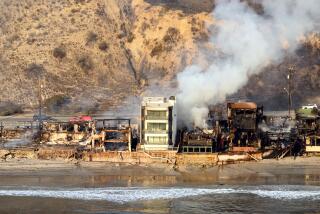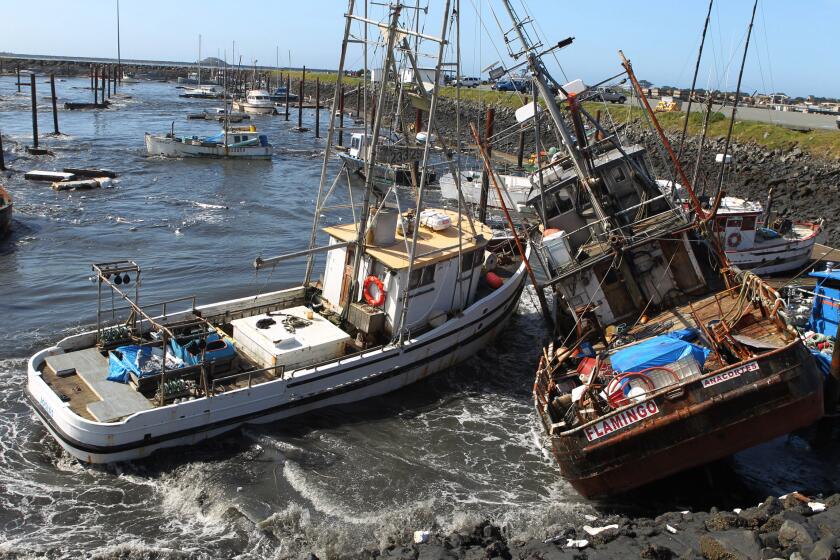Steel-Frame Repair Jobs Daunting : Quake: As demands of a new city law begin to be met, high-rise tenants and owners fret over disruptions, expense. Inspections alone can cost up to $1 million.
- Share via
Last November, Rosalind Zuckerman had to move her West Los Angeles law firm after ultrasound testing detected hidden cracks from the Northridge earthquake in the steel girders that held the Marathon Bank building together.
Along with several other tenants--all ordered out on three days’ notice--Zuckerman resettled in another Olympic Boulevard mid-rise a few blocks away.
Now it’s happening again.
Last month, the management of the West Side Towers took out a city building permit to begin an estimated $3 million in repairs to the building’s steel girders.
“If this one is going to be yellow-tagged [and closed], I would be very upset,” Zuckerman said.
Her anxiety will soon be shared by thousands of office workers--and their buildings’ owners--as the city’s steel-frame repair law finally starts to deliver its punch.
The City Council adopted the ordinance Feb. 22 in response to the discovery that the Northridge quake had caused severe cracking in many steel columns and beams, shattering the engineering community’s confidence in steel-frame construction.
Since May, city inspectors have hand-delivered hundreds of notices to offices in the San Fernando Valley and parts of the Westside instructing building owners to inspect--at the owners’ expense--for cracks that can be hidden behind walls with little or no visible quake damage.
The ordinance covers areas where damage to steel-frame buildings is thought to be concentrated, including the entire Valley.
After receiving the notice, owners have 180 days to report their inspection results to the city and another 90 days to obtain repair permits if damage is found. The ordinance then gives them two years to complete the necessary repairs.
Having no accurate list of buildings, the Department of Building and Safety this spring sent inspectors to every major street in the ordinance area, looking for suspect buildings. More than 500 notices eventually went out, but about 150 have since been dropped after owners informed the city that the buildings were not of steel-frame construction, Chief Inspector Russell Lane said.
The cost of the repairs is expected to rise into the hundreds of millions of dollars. Even the inspections can cost close to $1 million for a large building.
“Right now the majority of the building owners are just beginning to face the reality of the cost,” said attorney Pamela Westhoff of O’Melveny & Myers, who represents both owners and tenants of office buildings. “They’re thinking, ‘How am I going to amass the funds if I can’t get them from the insurance company?’ ”
By last week, the first six inspection reports to reach City Hall indicated that costly repairs would be required. Three reports outlined quake-related steel-frame repairs of $180,000 to $3 million each, said Yeuan-Wan Chou, the city’s major structures plan check supervisor.
Repair permits were also issued for another 11 steel-framed buildings before city inspectors had ordered them, with cost estimates averaging just under $1 million per building.
In their scramble to pay for the repairs, some owners have warned their mortgage holders that they will go into default if they can’t renegotiate their loans, while others have hinted they may try to pass the bill on to tenants, Westhoff said.
The slow pace of the city’s enforcement campaign, delayed almost a year by political squeamishness over the costs and unanswered engineering questions, has allowed the engineering community to consider how the inspections and repairs should be done.
A committee of engineers and state officials expects to release guidelines in August with a range of options: from inspecting a large percentage of a building’s steel joints visually to investigating a smaller number with ultrasound devices, said Ronald O. Hamburger of EQE International, one of the engineers.
The pioneers in steel-frame repair have forged some good news, showing that it is practical to conduct massive welding on high-rise buildings with only minor disturbance of tenants. “They’re doing it at night and, actually, they’re forcing me to go home at a reasonable hour,” said attorney Richard Block, whose office is in the 18-story Pinkerton building in Encino.
After he leaves, dozens of TriTech construction workers wrap every square foot of wall and carpet in plastic sheeting, roll out huge blowers to exhaust welding fumes and then erect tents of fireproof blankets around the exposed steel columns. During the night, welders work inside the tents, torching away damaged metal and replacing it with new welds. By the time Block returns each morning, every sign of their presence has been whisked away.
The opposite approach at the Tarzana Medical Office Building is to work from the outside by peeling off glass plates and rolling scaffolding down the building’s side, allowing workers to inspect and reweld steel girders without intruding on tenants.
Still, the absence of heavy exterior damage is no guarantee against a building having problems serious enough to require evacuation.
For example, until a bank officer asked for ultrasound inspections before approving a mortgage for St. Johns Medical Plaza in Santa Monica last November, no one in the five-story building had any cause for alarm.
An inspection revealed that 86 of 96 welded steel connections were cracked.
The owners, who were not insured for quake damage, obtained a $1.5-million Small Business Administration loan and bank financing to cover the rest of the $3-million-plus job, which began on a night-and-weekend schedule so that tenants could remain.
Then, in April, workers made a startling discovery. One of the 36-inch steel columns supporting a floor was cracked clear through above and below the concrete slab. Tenants were immediately evacuated and began moving back only this month, when the job was done.
The Building Owners and Managers Assn. of Los Angeles says that many building owners already in heavy debt will be unable to finance such repairs. It is sending a letter to its 2,000 members proposing a special Wall Street bond issue to raise money for the steel-frame repairs.
Financial constraints, which steer many building owners to make the minimal repairs, appear to have taken the urgency out of the question that still perplexes engineers: how best to repair welded beam and column connections.
Tests have shown that a variety of connectors can add considerable strength, said Thomas A. Sabol, president of the Los Angeles engineering firm of Englekirk & Sabol. But owners have shown little interest because of the added cost.
In its August guidelines, SAC Joint Venture, the state committee studying steel-frame repairs, will acknowledge that buildings remain vulnerable to damage in future earthquakes if repair crews merely reweld broken connections without adding strengthening devices, Hamburger said.
The report, however, will note the even more widespread hazards posed by other structures such as concrete tilt-ups, which failed extensively in the Northridge quake, and the many unreinforced masonry buildings that still have not been strengthened.
More to Read
Sign up for Essential California
The most important California stories and recommendations in your inbox every morning.
You may occasionally receive promotional content from the Los Angeles Times.











